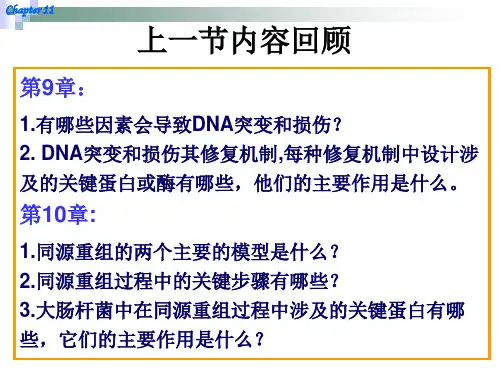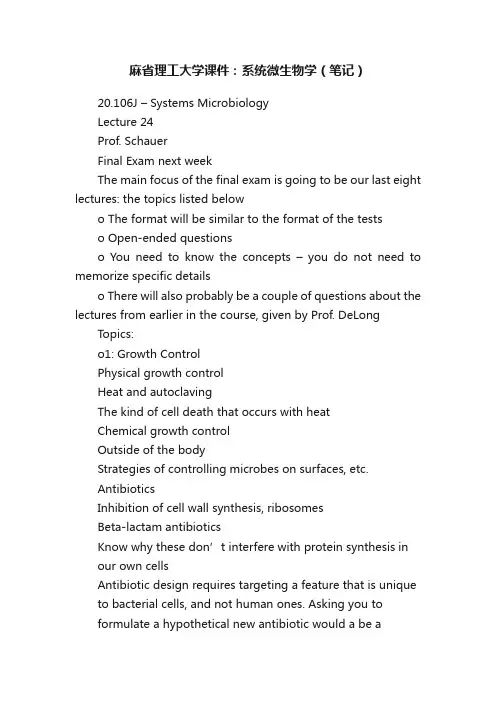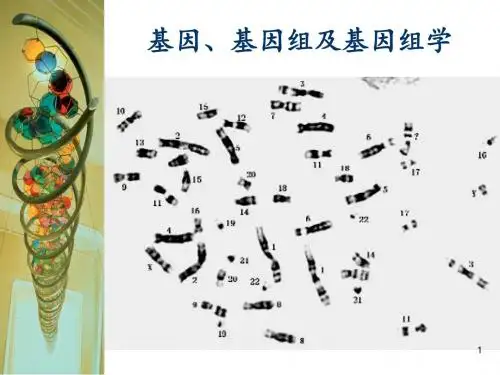麻省理工大学课件:系统微生物学11-基因组学I(笔记)
- 格式:pdf
- 大小:32.96 KB
- 文档页数:3



麻省理工大学课件:系统微生物学(笔记)20.106J – Systems MicrobiologyLecture 24Prof. SchauerFinal Exam next weekThe main focus of the final exam is going to be our last eight lectures: the topics listed belowo The format will be similar to the format of the testso Open-ended questionso You need to know the concepts –you do not need to memorize specific detailso There will also probably be a couple of questions about the lectures from earlier in the course, given by Prof. DeLong Topics:o1: Growth ControlPhysical growth controlHeat and autoclavingThe kind of cell death that occurs with heatChemical growth controlOutside of the bodyStrategies of controlling microbes on surfaces, etc.AntibioticsInhibition of cell wall synthesis, ribosomesBeta-lactam antibioticsKnow why these don’t interfere with protein synthesis inour own cellsAntibiotic design requires targeting a feature that is unique to bacterial cells, and not human ones. Asking you toformulate a hypothetical new antibiotic would a be areasonable question on the test.Antibiotic resistanceKnow that the existence of antimicrobial resistancepredated our own medical use of antibiotics. Why is that?o2: Microbe-host InteractionsHealthcare-associated infections (HAI)Know about the acquisition of drug resistance by some ofthese microbes in peopleVRE, MSRAThe fear of developing a superbug that we have to drug to treatCommensal microbiota (ecology, models)You should be familiar with the concept that there aremicrobes that live in every living thing on earthKnow about the development of a climax community ofmicrobiota in the human gut as people grow up frominfants to adultsGnotobiotic animals: in the lab, people can create rabbits,mice, or pigs grown in a sterile environment so that theyhave no microbiota inside them.You might be able to make some comparisons between our endosymbionts and those of aphidso 3.4: Immunology I and IIImmune cellsBe familiar with the main components of the immunesystemKnow the main components of lymphocytesKnow what B and T cells do once they become activated,what they secreteInflammation, phagocytosisNatural immunityGetting microbes out of the injured siteAdaptive immunity (Ag, MHC, T, B)Know the way that antibodies recognize antigens, ascompared to the way that T cells can recognize themB cells bind to conformational antigensAffinity maturationo Creates a little extra diversity in a B cell responseo However, this does not happen in T cells, because itwould be catastrophic to have T cells that recognizedifferent things –you don’t want them to startattacking your own cells. They need to recognizeyour own MHCVaccines (types)Know about the general types of vaccinesYou won’t have to name specific vaccinesUnderstand the range of successful vaccines that have been usedFor example, there’s the TB vaccine, which only protectsagainst childhood TB. You can’t give a vaccine like that to immuno-suppressed people – it could kill themAnergy (tolerance)HypersensitivityType I: IGEType IV: TB test is an exampleo5: Diagnostic MicrobiologyExotoxins: A-B toxins, SAg (Super antigens)Super antigens bind to the conserved parts of the TCR and the APCo They stimulate large numbers of T cells that sharecommon variable regions of the Beta chaino Whole sale stimulation, release of large quantitiesof cytokinesSelective, differential mediaSelective media to inhibit growth of commensalsYou can also make differential media, such as adding sugars or pH sensitive dyesMAb, serologyo6: Person-to-person TransmissionTB (risk factors, pathogenesis)Many people get exposed, many people develop latent infectionsIf they become immuno-suppressed, they can develop active TBInfluenzaAntigenic shifto Large, sudden changesAntigenic drifto Small changes in the proteins compromise the ability of your system to protect you from the virus Hp Only a small proportion actually develop peptic ulcer diseaseo7: EpidemiologyTermsIncidence, prevalence, control, transmission Emerging infectious diseaseso8: Arthropod-borne and Zoonotic DiseasesPlague (epidemiology, pathogenesis)Wild rodents, transmission through fleas on a sporadic basisBe familiar with how plague affects the flea life cycle, causing it to bite more peopleBubonic, Systemic, and Pneumonic forms of plague。







20.106J – Systems Microbiology
Lecture 11
Prof. DeLong
¾Chapter 15 – Brock
Genomics
o DNA sequencing technology – things have really changed. There’s a real race going on for who can develop the best technology
Human genome project: only around 30,000 genes in the human
code.
The day is not at all far off when doctors will read people’s
genomes to discover what their inherent risks are.
The human genome project involved two main groups – one more
commercially based (J. Craig Venter – Celera), and one more
public, open source, with funding from NIH (Francis Collins –
NHGRI). Also the Sanger Centre, Whitehead Institute…
The human genome project drove innovation in biotechnology. Two major technological benefits:
o Stimulated development of high throughput methods – the assembly line.
It’s not just the individual with a pipette any more – it’s more like a
factory approach (which matters for the social aspect of how science
works).
However, this might work back in the other direction as efficient
machines develop…
o Reliance on computational tools for data mining and visualization of biological information
Biology is rapidly becoming informational science –
bioinformatics and computational biology.
DNA sequencing
o Sanger’s technique
Uses primer extension and DNA polymerase
Dideoxynucleotides halt the replication at particular base pairs.
Then you run for length on a slab gel, and you can tell which base
pairs are at which locations, reading off the sequence and
recording them manually.
o Later people realized that you can use fluorescent labels instead of
radiolabels.
This meant that you didn’t have to deal with radioactivity
It also meant that you could run them all in one lane.
Instead of a slab gel, people use a thin tube, with a fluorescence
detector automatically reading the wavelengths as they come out
the other end.
This method is fast and accurate
o Graph: the progress of the Human Genome Project
o Shotgun genome sequencing – what about the gaps?
Doing a complete sequence for a bacterial genome is still
expensive – around 10 or 20 thousand dollars, but it’s relatively
straightforward.
o Small insert cloning/sequencing
o There are automated plate pickers now
o Some people thought that shotgun sequencing would work (the Celera group used this) but others thought that it wouldn’t (the public consortium
used a different method)
o BAC sequencing – larger segments, you know where they lie on the genome
o Both approaches have advantages: shotgun sequencing is much quicker, but BAC sequencing closes the gaps – the best method is to use some of
both.
o454 Sequencing – Commercial, massively parallel DNA sequencing technology:
Run PCR with beads, each of which attaches to on strand of DNA
Emulsion PCR
Lots of DNA comes from an individual strand.
You pour the reaction over a chip with tiny wells that each fit one bead.
1.5 million reactions all at once
Thus the factory approach to sequencing is no longer necessary – it can all be done in little machines like this.
It’s still pretty expensive, but it’s getting closer, and it’s changing things rapidly.
o The evolution of sequencing is moving towards nano-methods, and pretty soon there will probably be sequencing technologies in hospitals.
Microbial genomes
o The first complete, published microbial genome came in 1995.
o Incomplete bacterial genomes in process is now approaching 2,500.
o Archeal genomes have been studied less.
o Most of the DNA sequencing is happening at select sequencing centers, and it will probably continue to consolidate in this way.
o Archeal genomes are generally smaller.
o The smaller genomes are typically associated with obligate parasites.
There are obligate symbionts in some insects that live inside the
cell and just work as little amino acid factories.
•Called Carsonella
•They have extremely small genomes
•It’s also very very AT rich (very little GC content)
•The genome basically only has replication mechanisms and
the DNA for amino acid synthesis
•These symbionts are on their way toward becoming
essentially organelles
o We’re figuring out what sort of genes scale with genome size.。